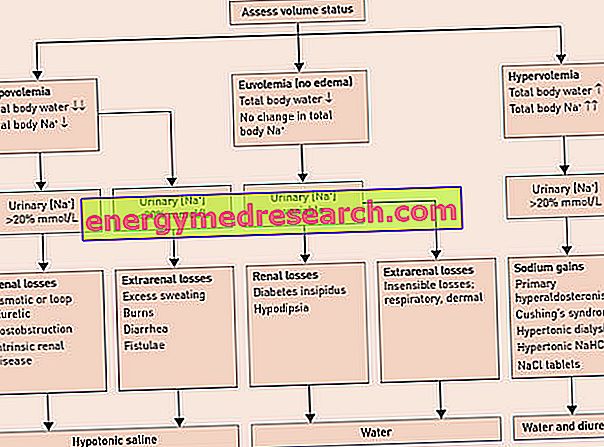Generality
In medical practice, " microcitemia " is a term that is used to indicate two different conditions.

In particular, this can be synonymous with:
- MICROCYTOSIS : hematological picture that can be found with blood tests, in which red blood cells are smaller than the norm. Therefore, the microcitemia assumes a meaning of clinical sign and, as such, it can signal the presence of some diseases and guide the process to formulate the definitive diagnosis of the same;
- β-THALASSEMIA or MEDITERRANEAN ANEMIA : group of inherited hematologic diseases, in which the synthesis of beta hemoglobin chains is reduced or absent. In this situation, therefore, the microcitemia assumes the meaning of pathology .
What's this
1. Microcythemia: what is Microcytosis?
The microcytemia understood as microcytosis is a condition characterized by the presence, in the peripheral blood, of red blood cells of smaller size than the norm.
These smaller elements are defined by different synonyms, including microcytic erythrocytes and microcytes .
The presence of microcytes is frequently related to anemia . In this case, in addition to the microcitemia, the average concentration of hemoglobin (Hb) contained within the red blood cells is lower and, consequently, the capacity of the blood to carry oxygen is reduced.
2. Microcythemia: definition of β-thalassemia
Microcythaemia (or β-thalassemia ) is an inherited blood disorder characterized by:
- Reduced amount of red blood cells compared to the norm (for this reason, the microcitemia is also called Mediterranean anemia);
- Defects in the synthesis of hemoglobin beta chains (Hb) which result in a lack of oxygen in the body.
The extent of the disorder, the symptoms and the consequences are very variable and depend fundamentally on the type of genetic defect.
From the clinical point of view, in fact, we distinguish 3 different forms of beta-thalassemia:
- Thalassemia major (or Cooley's disease ): it is the most severe variant; to survive, the patient must undergo periodic blood transfusions throughout the course of his life, in addition to taking specific drugs. This form of beta-thalassemia generally appears within 2 years of age;
- Intermediate thalassemia : it is a less severe form than the previous one; it can remain latent or manifest itself in a similar way to the major variant and need occasional transfusions;
- Thalassemia minor : it is generally asymptomatic, does not require special treatments, but regular checks of blood values.
To know
The thalassemias (also called thalassemia syndromes ) constitute a heterogeneous group of hereditary hemoglobinopathies, characterized by the reduced or absent synthesis of one or more of the four protein chains ( globins ) that constitute hemoglobin . It must be remembered, in fact, that this molecule is composed of four subunits: two alpha chains and two beta chains . On the basis of the defect, therefore, we distinguish α-thalassemias and β-thalassemias .
Causes
1. Microcythemia: what causes Microcytosis?
The microcitemia can be caused by various conditions.
In most cases, circulating smaller erythrocytes is an indication of:
- Alterations that interfere with erythropoiesis (including genetic mutations responsible for hereditary microcytosis);
- Defective or insufficient synthesis of hemoglobin .
The microcitemia is often related to iron deficiency anemias (or iron deficiency anemias) and is frequent in the presence of thalassemia syndromes, inflammations or chronic diseases (such as rheumatoid arthritis, Crohn's disease, nephropathy, infections and certain neoplasms).
Read more: Microcythemia (Microcytosis) - Causes and Possible Consequences »1. Microcythemia: what are the causes of β-thalassemia?
Microcythaemia is a form of thalassemia caused by a reduced or absent synthesis of beta-globin hemoglobin chains.
The consequences of this dysfunction can be summarized as:
- Clinical picture of microcytic and hypochromic anemia ;
- Early destruction of red blood cells ( hemolysis ), with different relapses throughout the body;
- Ineffective erythropoiesis of variable severity (the bone marrow produces small, fragile red blood cells which are above all poor in oxygen to be transported to the tissues).

At the base of the microcitemia, there are very heterogeneous genetic aberrations (point mutations, deletions, etc.) on the HBB gene (11p15.5) which encodes β-globins . These alterations involve the poor (β +) or absent (β0) production of beta chains: the resulting hemoglobin is scarce and damages the red blood cell membrane, which are inadequate to carry out their task of transporting oxygen throughout the organism and are thus destroyed.
The transmission of microcytemia occurs in an autosomal recessive manner, so only a child whose parents are both carriers can be affected by the disease.
To learn more: Thalassemia - Etiology and Classification »Symptoms and Complications
1. Microcythemia: which symptoms does Microcytosis have?
Depending on the cause that caused it, microcytemia - understood as microcytosis - can manifest itself in association with highly variable symptoms. In some cases, this condition is almost asymptomatic, other times it involves the typical anemia disorders or, again, it correlates to a strongly invalidating clinical picture.
In most cases, the symptoms of microcytemia are determined by the fact that the size of red blood cells in the blood is reduced .
This leads to a reduction in the activity of transporting oxygen, which involves more frequently:
- Skin pallor (accentuated especially at face level);
- Fatigue and weakness;
- Palpitations;
- Low body temperature;
- Loss of appetite;
- Headache;
- Dizziness;
- Fragility of nails and hair;
- Shortness of breath.
When microcytemia is severe and the underlying causes are not adequately treated, various complications can arise, such as jaundice, tendency to bleed, hypoxia, hypotension, splenomegaly and heart problems.
2. Microcythemia: how does β-thalassemia occur?
The microcitemia (or β-thalassemia) presents itself with very variable clinical signs which depend, as anticipated, on the severity of the genetic aberration at the base. The mild forms of this pathology can be almost asymptomatic, while the more serious ones, such as the major variant, involve:
- Progressive pallor;
- Fatigue;
- Muscle weakness;
- Slow development and jaundice in the child;
- Bone changes (thickening of the skull, protruding cheekbones, valgus knee and pathological fractures of long bones);
- Anorexia (lack of appetite);
- Cancellation of the general conditions;
- Recurrent fever attacks;
- Diarrhea;
- Irritability;
- Progressive distension of the abdomen (secondary to splenomegaly and hepatomegaly).
The microcitemia and the therapies directed to the management of the same pathology predisposes to the development of various complications :
- Osteoporosis : to compensate for the lack of red blood cells, the bone marrow will strive to produce more. This reaction results in the tendency to form longer and more fragile bones;
- Splenomegaly : similar mechanism concerns the spleen that will face the same effort to destroy deficient or damaged erythrocytes. The consequences are an enlargement of the organ which, moreover, is "distracted" by other functions, such as contributing to the defense of the organism against infections.
- Toxicosis : the frequent blood transfusions that involve the treatment of microcitemia in severe form, create an accumulation of iron, with the risk of incurring damage to organs, such as the liver and the heart.
Other possible consequences of microcitemia include:
- Endocrine disorders and hormonal imbalances (including hypothyroidism, parathyroid and adrenal insufficiency, and diabetes mellitus);
- Cholelithiasis (as in sickle cell anemia);
- Skin ulcers in the lower limbs due to chronic venous insufficiency.
Diagnosis

What tests can diagnose microcythemia?
- Microcytosis : the presence of microcitemia is found by undergoing a blood test, which evaluates, in particular, the erythrocyte indices. In the laboratory analysis, the most useful blood chemistry parameter to determine if red blood cells are normal, too large or too small, is the mean corpuscular volume (MCV).
- Beta-thalassemia : microcytemia, understood as Mediterranean anemia, can be identified by genetic tests and blood tests; the latter will show, in particular, the presence of red blood cells of irregular, fragile, scarce dimensions and smaller than the norm.
Treatment
1. Microcythemia: how is Microcytosis treated?
The management of microcytemia (microcytosis) is different depending on the type of cause and, in general, may include the intake of iron and vitamin C supplements, diet modification and more or less recurrent blood transfusions . Sometimes, the disorder is transient and does not require any specific therapeutic intervention.
The cure of the pathologies responsible for the microcitemia usually determines the resolution of the clinical condition. It should be noted, however, that some forms of microcytosis - such as those caused by thalassemias - are congenital, and therefore cannot be cured. In any case, the doctor will be able to advise the patient on the best interventions to manage their condition.
2. Microcythemia: what treatment is provided for β-thalassemia?
The treatment of microcytemia (beta-thalassemia) involves different approaches, including:
- Blood transfusions : they are indicated to make up for the lack of red blood cells. In general, the major variant involves treatment with regular blood transfusions (on average one every 15 days in the most severe cases), while in the intermediate microcytemia a few cycles are sufficient when the hemoglobin is too low. However, transfusions cause an accumulation of iron in the body which can cause problems especially in the heart and liver. To prevent this damage, it is necessary to establish a continuous therapy with iron-chelating drugs, that is able to trap and eliminate excess iron from the body.
- Splenectomy : it is an intervention indicated in the case in which the microcitemia causes a serious anemia or the enlargement of the spleen (splenomegaly).
- Bone marrow or stem cell transplantation from compatible donors : it is the only "definitive" therapy for Mediterranean anemia. However, the chances of finding a compatible donor are limited (about 25%), without considering the contraindications and the risks of this type of intervention, including the rejection by the organism. For these reasons, this procedure is usually reserved for rare cases, in the presence of people suffering from a very severe form of Mediterranean anemia and with available HLA-identical family donors (brothers or sisters of the patient).
In addition to specific therapies, great importance is given to regularly practiced physical activity and nutrition. In particular, it can be useful:
- Limit foods rich in animal origin and rich in iron, such as liver, pork, beef, offal and mussels;
- Accompany meals with tea in order to reduce iron absorption;
- Consume foods rich in calcium and vitamin D, due to the risk of osteoporosis;
- Take folic acid supplements (to increase red blood cell production).



